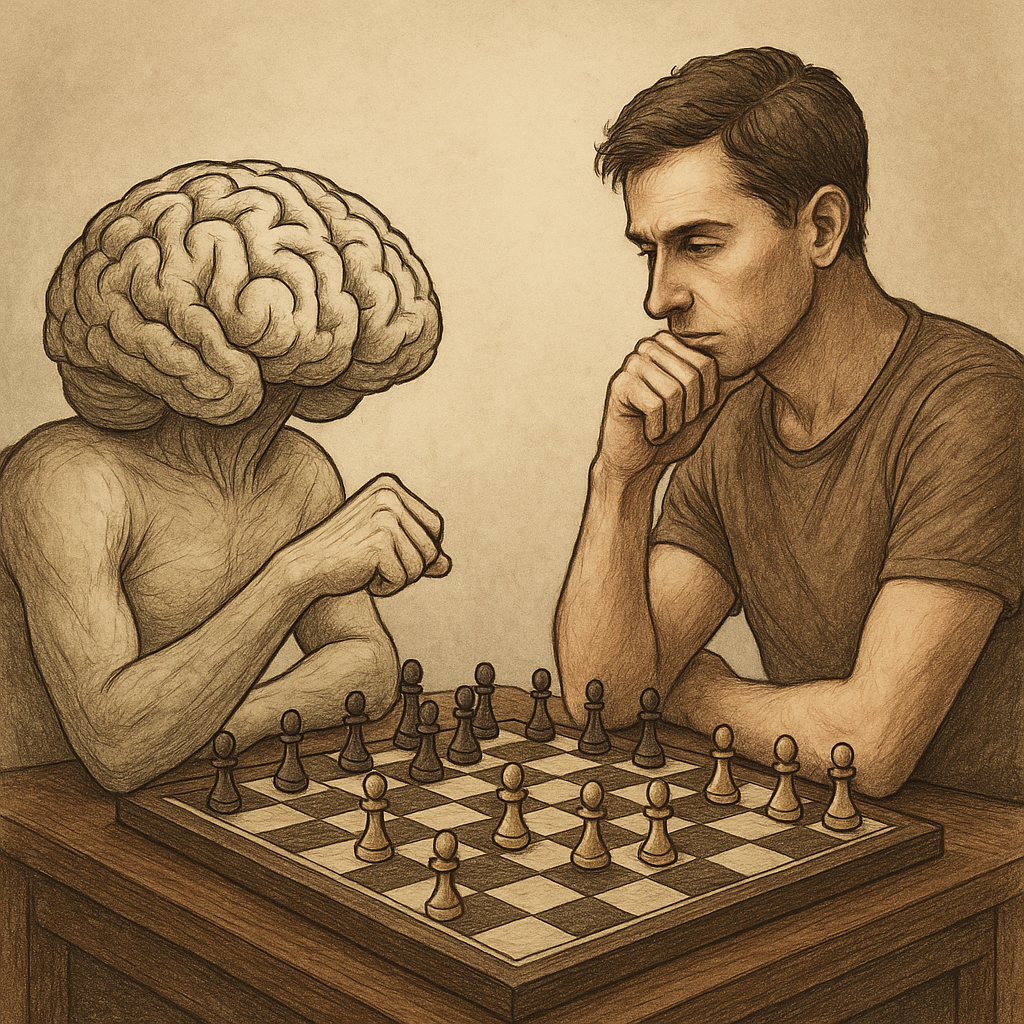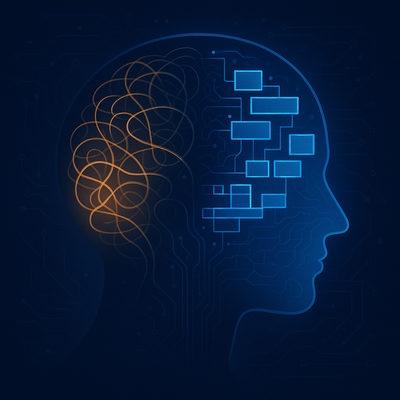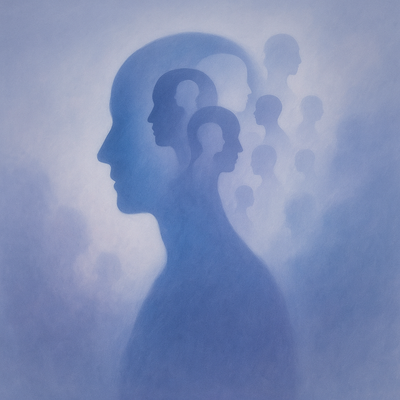Sometimes when everything is fine, like we've had a good sleep, we've eaten good food, we've exercised, we've listened to peaceful music, so to speak, when we should be at peace, a feeling of fatigue, tension, disharmony with the universe comes over us.
It's as if we haven't slept for days, we've been hungry, something bad has happened to us, and we've just collapsed.
Then we think about it, why could it have happened? Think, think... No... No reason, just a low mood, moodiness.
It's as if something unseen has happened, and we have somehow suppressed these incoming signals, and the body is like, whoa brother, wait a minute, we're not machines either.
In this article, I will try to think a little bit about this situation, think about it and try to examine how we can turn this feeling of anxiety, fatigue and restlessness in our favor by achieving body-mind harmony.
We call it emotional transformation, we are striving for physical and spiritual soundness, it would be incomplete if we did not examine this situation.
As always, I will try to go through the approaches of philosophers, scientists and society.
Philosophical and Scientific Background
Perspective:
Merleau-Ponty: What is "Thinking in the Body"?
Merleau-Ponty is one of the most important representatives of the phenomenology movement that developed in France in the 20th century and focused on understanding human experience.
His central argument is this: Thought is not only a mental activity but also a bodily experience.
This point of view is a direct challenge to the body-mind distinction prevalent in classical philosophy.
According to Merau-Ponty, the body precedes the mind. Everything that happens is first perceived by the body; the mind interprets this perception only later.
Without further ado, we can summarize as follows:
"I think, therefore I am" instead of saying,
"I perceive with my body, I give meaning to the world through this perception; therefore I am" is closer to Merleau-Ponty's approach.
Spinoza: Unity of Mind and Body
According to Baruch Spinoza, one of my favorite philosophers, mind and body are not two separate entities, but two different aspects of the same reality.
For him, there is only one "substance" in the universe. He perceives it as God or Nature ("Deus sive Natura").
This substance includes both mental and physical properties. That is, it both thinks and occupies space.
This perspective offers a radical alternative to Descartes' dualist conception. Whereas Descartes saw the mind as a separate essence outside the body, for Spinoza the mind is an internal expression of the body.
State of the body = State of the mind
In Spinoza's thought:
The mind is the "idea" of the body.
That is, everything that happens in our body (sensations, movements, internal states) has a parallel counterpart in our mind.
In his view, mind and body are not separate, but rather like different expressions of the same thing,
like both the notes and the sound of a piece of music.
Descartes' Dualism: The Separation of Mind and Body
René Descartes is considered one of the founders of modern philosophy and is especially known for his statement "I think, therefore I am" (cogito ergo sum).
In his narrative based on this idea, he bases human existence on two distinct substances:
- Res cogitans: That which thinks (mind, consciousness, soul)
- Res extensa: That which occupies space (body, matter)
So, according to Descartes, mind and body:
- Have different properties (one thinks, the other occupies space, i.e. occupies space),
- They are separate entities, but together they constitute the human being,
- There can be direct interaction between them (e.g. emotions affecting the body), but their natures are entirely different.
I would like to inform you that when I share these philosophical perspectives, I tend to distill my own philosophical point of view by understanding all of them, seeing what kind of perspectives they are, rather than choosing one of them, and I want you to know that I am trying to draw you there.
What were the consequences of this view of Descartes?
This view left a deep mark on Western thought for centuries.
- The mind was said to rule the body; the body was perceived as a passive machine.
- The soul and body were treated as separate entities; issues such as the conflict between reason and emotion were examined; the mental was seen as "superior" and the physical as "inferior".
- In medicine, it led to the separation of psychological problems and physical illnesses (such as the long disregard of psychosomatic relationships).
Scientific perspective:
Somatic Sensations: Wisdom from Within the Body
The word "somatic" comes from the Greek root "soma" (body).
Somatic sensations are signals from within the body, not from the outside world, but from our own internal state.
They are perceived with bodily awareness, not with thought.
The main types of somatic sensations:
Interoception:
Noticing signals from internal organs.
For example, when our heartbeat speeds up, it feels like something exciting is going to happen, or when our stomach contracts, we feel anxious, like something is going to happen to us.
Propriosception:
Awareness of muscles, joints, posture and movement.
For example, close your eyes. It is this somatic sensation that allows you to know where your hand or foot is without having to think about it.
This, together with movement, is the basis for the feeling of "thinking in the body".
Vestibular sensation:
The internal sensory system that provides a sense of balance and direction.
When a malfunction occurs in this system (which has happened to someone close to us, if not to all of us: riding a Ferris wheel or a roller coaster, the crystals in the ear become dislodged and the person is unable to walk for a while), the prolongation of this condition also affects mental balance.
People can become more restless, more irritable, more intolerant.
Somatic sensations are what the body is silently saying to the mind.
If we don't listen, the body shouts. If we listen, it guides.
Vagus Nerve: The Body's Subliminal Message Carrier
The vagus nerve is the longest and most complex cranial nerve in our body. It originates from the brain and extends to the face, throat, heart, lungs, lungs, stomach and intestines.
Why is it important?
It is the parasympathetic part of the autonomic nervous system. That is, it governs states such as "calming down", "digestion" and "healing".
It provides two-way communication between the brain and the body.
80% of it is the nerve that carries information from the body to the brain.
The mind learns most information from the body.
Relation to emotions:
People with high vagus tone (tension, strength) are better able to cope with stress, emotional regulation and inner balance.
If tone is low: chronic anxiety, digestive problems, sleep disorders, social withdrawal, etc.
Emotions are not only experienced "mentally"; they are experienced physically through the vagus.
We can think of it as a channel through which the heart, stomach, lungs talk to our thoughts.
Let's remember what we are told in very stressful, upsetting moments:
Take a deep breath. Do this and you will calm down.
The reason for this is this: If we breathe deeply, our diaphragm presses on our vagus nerve, which tells our mind: calm down, everything is fine, we calm down.
Physiological Representation of Emotions: Brain Body Communication
Amygdala: Emotional Alarm Center
The amygdala is an almond-shaped structure deep in the brain that plays a key role in the processing of intense emotions, especially fear, threat, anger.
It is like an internal alarm system:
When it senses danger, it triggers the body's fight-or-flight response before it fully understands "what is happening".
This can:
- Speed up our heartbeat
- Speed up our breathing
- Tense our muscles
- Slow down our digestion
- Slow down our digestion
- All of our attention is focused on the threat
Emotion here is not "a thought", but a chain of physiological events
Prefrontal Cortex: "Feeling before thinking"
While the amygdala is instantly activated, the forebrain (prefrontal cortex) takes on the task of interpreting and regulating emotion.
But this functioning is not always in balance:
- When the amygdala is working too fast and too strongly, logical thinking can be disabled (e.g. panic, anger outburst).
- The prefrontal cortex does not "neutralize" the emotion; it gives us the ability to understand, regulate and consciously choose a response.
Body = Stage of Emotion
Every emotion leaves a mark on the body:
Sadness → heaviness in the chest, stomach cramps
Fear → tense muscles, trembling
Happiness → expansive breath, relaxation, feeling of warmth
Anxiety → nausea, rapid breathing, tingling
These physiological reflections show that what we call emotion is not "just mental".
Emotion is something the body experiences, not something the mind thinks.
Traces of Trauma in the Body: The Mind Forgets, the Body Remembers
Bessel van der Kolk and "The Body Keeps the Score"
Psychiatrist Bessel van der Kolk, one of the most important figures in trauma studies, argues in his famous book "The Body Keeps the Score" the following basic idea:
Trauma is not only a mental scar; it also leaves a mark on the memory of the body.
What are the physical scars of trauma?
- Continuous alertness may be triggered
- Digestive disorders may be experienced
- Freezing or sudden outbursts of anger
- Inability to breathe deeply, chronic muscle tension
- Hypersensitivity to touch or sound may develop.
The mind may have forgotten the "event", but the body may still not have received the "all clear" signal. Here the trauma remains in the body as an "incomplete loop".
Somatic Therapy: Sensations Before Words
Somatic therapy is an approach to therapy that seeks to transform trauma by working with the sensory traces of the body.
Methods include:
- Bodily awareness exercises (interoception, proprioception)
- Non-triggering light touches
- Breath, voice, eye movements
- Recompletion of movements that were "frozen" during powerful events (e.g. raising the hand, shouting)
The basic idea here is that:
Emotion is experienced in the body before speech.
Therefore healing must also start in the body.
Societal/cultural perspective:
Performance Culture and the Reduction of the Body to a "Tool"
The body in modern society, It has increasingly become "a machine that produces output", "a visualized object of achievement", or "a showcase of identity presented to the outside world".
Function & Feel
Performance culture forces us to see the body as existing not to feel, but to "optimize."
Metrics like "how many steps did you take today?", "how many calories did you burn?", "how many pounds did you lift?", metrics such as "how many steps did you take today?", "how many calories did you burn today?", "how much weight did you lift?", etc. take the bodily experience out of the internal and tie it to an external scoring system.
This makes the relationship with one's own body an objectified, evaluated thing instead of a subjective awareness.
It is as if our body is not in touch with our feelings, but with what others think.
Thus, the body becomes a project to be accomplished rather than a state of "being".
The Artificiality of Bodily Representations in Social Media
Bodies in social media are often not "real" but constructed, filtered, light-sculpted images.
It would be useful to take this not as a criticism but as an observation. Inevitably, this can lead us to internalize and worry about problems that are not real - why am I not so beautiful, why don't I have it -
But these images are neither purely physical nor personal. The only concern of social media tools is to work in a way that can get more interaction, and this is shaped according to the social liking algorithm of the geography.
If we are not aware of this, our bodies here, after a point, they no longer answer the question "who am I?", but "how many likes will I get?". Then depression, then poor health.
Visibility becomes a form of marketing, not of expressing the body.
What happens in the end?
- The relationship with the body becomes external, not internal; visual, not affective.
- And over time, the person becomes alienated from their own body. He cannot even feel when he needs to rest, when he is thirsty, when it hurts.
Real Problems and Solutions
Problem areas:
One of the most common internal contradictions of modern man is this:
Instead of feeling emotions, we try to analyze them and "solve" them as if we were solving a math problem.
This usually goes like this:
Feeling distress, anxiety or resentment, but not going into the feeling.
Instead, the mind takes over: "This happened because...", "This is why I am like this...",
The feeling is treated like a math problem: If the cause is found, it is thought to be solved.
But...
Emotions are there to be felt, not to be solved.
Emotions that are solved without being felt are buried deep in the body and continue to exist there. They grow like snowballs and become knots that cannot be untied.
What Happens When Thought Suppresses Emotion?
When the mind overrides the emotion, the person is disconnected from the body. A void is created inside the person, and the person tries to fill this void by constantly thinking. This reproduces not the emotion itself, but the story around it over and over again.
Maybe if we felt the emotion, if we understood it, if we listened to it, if we realized it, it was telling us something and we could learn a lesson from it, but now our minds are full and our insides are empty.
Neglecting the Signs of the Body
In the pace of modern life, the body is often seen as just a "means of transportation".
When we feel hungry, when we feel tired, when we feel that "something is not right"...
Our mind often overrides, suppresses, rationalizes
these signals.
We keep telling ourselves things like:
- "Now is not the time."
- "Hang in there."
- "I'm always like this."
- "It will pass anyway."
At this point, let me remind you that we are focusing on the body's reactions.
In short, I am trying to say that if your heart is beating like it is going to explode, of course you will postpone, or if your stomach is cramping, don't say it will pass anyway, maybe it won't. For example, if you are at the point of vomiting, maybe it is because you need to vomit, stop and let go of what your mind is saying for that moment.
The reason why I am giving this warning is that these are vital issues, I hope nobody experiences something like this, they are not things to joke about and they are important things that can affect our health and even our lives, so I could not pass them by.
After all, the body never speaks in vain. It tries to tell us something in its own language, as much really as it can.
And when it is not heard... it starts to speak louder. He yells, he screams.
Let's not let him.
Chronic Tension: Physical Recording of Repressed Emotions
If you have physical behavior patterns such as
- Constant feeling of heaviness in the shoulders
- Clenched teeth involuntarily, perhaps while sleeping, clenching the jaw muscles
- Superficial breathing, difficulty breathing deeply
- Pain in the lower back, neck, back
- Heart palpitations "for no reason"
None of these are "for no reason".
Suppressed emotion, unexpressed anger, swallowed tears... All of them are somewhere in the body.
This state of chronic tension becomes normalized over time.
The person feels constantly tired, restless, "at war with life" but cannot explain why.
Solution ideas:
Somatic Awareness Practices: Remembering to Listen to the Body
Somatic awareness is the ability to observe the body's internal signals (muscle tension, depth of breath, heartbeat, temperature, etc.) without judgment.
This awareness calls one back to "one's own being"
Remembering to Listen to the Body
Body Scan:
- It is one of the most basic and widespread practices.
- Awareness is developed by scanning the body from head to feet, with eyes closed or open.
- The aim: The aim is not to evaluate, but simply to ask the question "what is there?" and to observe emotional/physical sensations.
- "There is a tension in my shoulder", not to try to change it, but simply to make space for its presence.
- Scientifically, it has been shown that: Body scanning practice decreases amygdala activity and increases prefrontal cortex activity, directly contributing to emotional regulation.
Conscious Movement (Somatic Micro-movements / Feldenkrais / Yoga etc.)
- Somatic awareness is not just a still focus; observing the relationship with the movement is also part of this awareness.
- What is important in such practices is not the accuracy of the movement, but the ability to remain mindful while moving.
- Specifically:
- Slow movements synchronized with the breath
- Stretching without putting unnecessary pressure on the muscles
- "Staying on the edge": neither pushing nor pulling, just being aware of the situation.
- "Living with your body" means being aware of what you are doing with it.
- Breathing exercises / techniques that support vagal tone
- Daily rituals to "make space for feeling" (dance, silence, touch)
Conclusion and Message to the Reader
Now that I am the one who writes, I don't want to pass without giving an example from myself, I would like to give an example from the times when I was not aware of it, it's been a while, I'm writing with shame, don't take it as an example.
I think it was about 15 years ago, I was working like a horse, so to speak, in order to gain more experience when I was considered neither a rookie nor skilled enough in business life, I spent a long time thinking whether my stomach hurts, I need to work, I need to work, my back is stiff, I need to succeed, I have exhausted my body a lot, now I realize looking back, fortunately, no permanent problem has occurred.
Anyway I've gone on too long, the bottom line is: listen to your body, don't ignore what it says, try to calm down, understand, figure it out, get support if needed, heal, and strive to become the best version of yourself by bringing body and mind into balance.
By the way I say all this to you, I am actually saying it to myself, I am writing down what I think, what I have researched and learned. Words fly, writing remains.
To summarize again:
Transformation is a bodily process, not just a mental one.
The relationship with the body opens the door to inner wholeness.
So if you asked your body today, what do you think it would want to tell you? Could it be that you rationalized things with your mind and didn't listen to it?
In my next post, I will discuss how we can maintain body-mind wholeness in everyday life.
We will explore together the role of rituals, routines and the body's capacity to "remember" in this process.
Till then, stay healthy with love and in balance with your body and spirit.









